|
|
|
Sort Order |
|
|
|
Items / Page
|
|
|
|
|
|
|
| Srl | Item |
| 1 |
ID:
113530
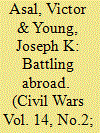

|
|
|
|
|
| Publication |
2012.
|
| Summary/Abstract |
Why are some terrorist organizations more likely to be targets of transnational counterterrorist operations? Previous work has identified characteristics of the environment or country involved to explain variation in targeting. We focus on characteristics of the violent organization to explain this variation. Using cross-national data on terrorist organizations and state targeting of these organizations, we identify several factors that help explain the variation in why some organizations are likely to be targeted while others are not.
|
|
|
|
|
|
|
|
|
|
|
|
|
|
|
|
| 2 |
ID:
081515


|
|
|
|
|
| Publication |
2007.
|
| Summary/Abstract |
From as early as the Roman Empire to the present day, governments have grappled with how best to respond to political violence from organized insurgent groups. In response to insurgent groups, some governments have emphasized a direct military response or what is often called 'attrition'. Other states have stressed a softer, political strategy or what is often called the 'hearts and minds' approach. Either approach places the population at the center of a struggle between the government and violent dissidents. Despite numerous works emphasizing either 'attrition' or 'hearts and minds', few theoretical studies have attempted to compare their relative success. Using an agent-based computational model, we examine which approach is more successful at quelling insurgencies and find that a hearts and minds approach is superior to an attrition strategy. We illustrate the model with insights from the Iraqi insurgency and, more generally, the model has implications for other insurgencies, such as in Chechnya.
|
|
|
|
|
|
|
|
|
|
|
|
|
|
|
|
| 3 |
ID:
132184
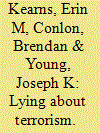

|
|
|
|
|
| Publication |
2014.
|
| Summary/Abstract |
Conventional wisdom holds that terrorism is committed for strategic reasons as a form of costly signaling to an audience. However, since over half of terrorist attacks are not credibly claimed, conventional wisdom does not explain many acts of terrorism. This article suggests that there are four lies about terrorism that can be incorporated in a rationalist framework: false claiming, false flag, the hot-potato problem, and the lie of omission. Each of these lies about terrorism can be strategically employed to help a group achieve its desired goal(s) without necessitating that an attack be truthfully claimed.
|
|
|
|
|
|
|
|
|
|
|
|
|
|
|
|
| 4 |
ID:
166665
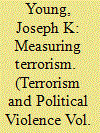

|
|
|
|
|
| Summary/Abstract |
In the conceptual literature on terrorism, there is no shortage of answers to the question: “What is terrorism?” Indeed, the terrorism literature has been heavily criticized for a deluge of definitions. And yet the booming quantitative terrorism literature generally examines a narrow set of “what is terrorism?”: how country-level factors explain variation in the number of terrorist attacks. This article demonstrates the variety of ways in which scholars currently operationalize terrorism and compares them to the ways it could be operationalized. I replicate studies using alternative operationalizations of terrorism to examine the consequences of the terrorism literature’s collective bet to focus on attack counts at the country level. Finally, I discuss the implications of the narrow set of operational choices with an eye towards how a greater variety of approaches would produce a more robust research agenda.
|
|
|
|
|
|
|
|
|
|
|
|
|
|
|
|
| 5 |
ID:
116339
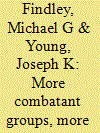

|
|
|
|
|
| Publication |
2012.
|
| Summary/Abstract |
We examine and test the logic that outbidding among insurgent groups results in more suicide terrorism specifically and more terrorism of any type, which has become a popular argument in recent years. A global analysis of terrorism from 1970-2004 provides scant support for the notion that outbidding increases suicide terrorism. An extension of the argument to all types of terrorist attacks provides even less support. The logic of outbidding has received considerable attention in academic and policy circles in recent years. 1
Similar to the argument that democratic occupation increases suicide terror, 2 our lack of empirical support suggests that considerable cross-national work is still needed to understand suicide terror adequately. We suggest some reasons why this may be the case, drawing particular attention to the problem of overgeneralizing from a limited set of cases.
|
|
|
|
|
|
|
|
|
|
|
|
|
|
|
|
| 6 |
ID:
108033
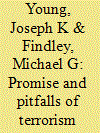

|
|
|
|
|
| Publication |
2011.
|
| Summary/Abstract |
Using a database of recent articles published in prominent political science journals, we show the rapid increase in terrorism research. Given this increased awareness and attention, we identify several problems that still plague the study of political terrorism including definitional problems that lack empirical tests, not distinguishing among different types of terrorism, and using the wrong unit of analysis when designing research. After identifying these problems-especially as they relate to the quantitative study of terrorism-we suggest some solutions. We then apply these suggestions to investigate whether changing the definition of terrorism, different types of terrorism, or changing the unit of analysis affects key predictors of terror events cross-nationally. One of our tests consists of varying the unit of observation to include directed dyads, which offers the potential to test some of the many strategic models of terrorism. Our analysis suggests that varying definitions of terrorism, such as military vs. non-military targets, might not be that consequential, whereas different types of terrorism, such as domestic vs. transnational, could be driven by fundamentally different processes. We also conclude that modeling transnational terrorism differently using directed dyads yields new and interesting insights into the process of terrorism.
|
|
|
|
|
|
|
|
|
|
|
|
|
|
|
|
| 7 |
ID:
120769
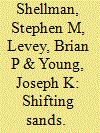

|
|
|
|
|
| Publication |
2013.
|
| Summary/Abstract |
Why does a dissident group go through phases of violence and nonviolence? Many studies of states and dissidents examine related issues by focusing on structural or rarely changing factors. In contrast, some more recent work focuses on dynamic interaction of participants. We suggest forecasting state-dissident interaction using insights from this dynamic approach while also incorporating structural factors. We explore this question by offering new data on the behavior of groups and governments collected using automated natural language processing techniques. These data provide information on who is doing what to whom at a directed-dyadic level. We also collected new data on the attitudes or sentiment of the masses using novel automated techniques. Since obtaining valid and reliable time-series public opinion data on mass attitudes towards a dissident group is extremely difficult, we have created automated sentiment data by scraping publicly available information written by members of the population and aggregating this information to create a pollof opinion at a discrete time period. We model the violence and nonviolence perpetrated by two groups: the Tamil Tigers in Sri Lanka and the Moro Islamic Liberation Front in the Philippines. We find encouraging results for predicting future phase shifts in violence when accounting for behaviors modeled with our data as opposed to models based solely on structural factors.
|
|
|
|
|
|
|
|
|
|
|
|
|
|
|
|
| 8 |
ID:
098249
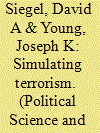

|
|
|
|
|
| Publication |
2009.
|
| Summary/Abstract |
We present two simulations designed to convey the strategic nature of terrorism and counterterrorism. The first is a simulated hostage crisis, designed primarily to illustrate the concepts of credible commitment and costly signaling. The second explores high-level decision making of both a terrorist group and the state, and is designed to highlight scarce-resource allocation and organizational dynamics. The simulations should be useful both in a traditional classroom setting as well as to the larger public. We provide a primer on the subject matter, and all the material necessary to run the simulations.
|
|
|
|
|
|
|
|
|
|
|
|
|
|
|
|
| 9 |
ID:
068950
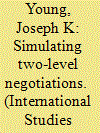

|
|
|
| 10 |
ID:
132394
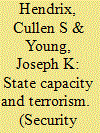

|
|
|
|
|
| Publication |
2014.
|
| Summary/Abstract |
Conventional wisdom suggests that dissident groups use terrorism when they face an overwhelmingly more powerful state, yet attacks in developing countries have predominated in the post-Cold War era, suggesting that terrorism is an increasingly weak state phenomenon. Cross-national studies of terrorism find mixed results for how common measures of state capacity influence terrorism. We argue that these indeterminate findings are due in part to a partial understanding of both what constitutes state capacity and how different aspects of state strength or weakness relate to the propensity of groups to use terrorism. We decompose state capacity into two dimensions that we theorize are particularly relevant to dissident groups: military capacity, or the ability to project conventional military force, and bureaucratic/administrative capacity. Our analysis supports the claim that terrorist attacks are more frequently targeted at states with large, technologically sophisticated militaries but less frequently targeted at states with higher bureaucratic and administrative capacity. We also compare two militarily capable states, France and Russia, that have had different recent experiences with terrorism to help illustrate the causal mechanisms involved. Evidence from our models and cases suggest that states can be capable in different ways, and these various capabilities create differing incentives for using terror as a strategic and tactical tool.
|
|
|
|
|
|
|
|
|
|
|
|
|
|
|
|
| 11 |
ID:
121585


|
|
|
|
|
| Publication |
2012.
|
| Summary/Abstract |
What is the relationship between civil war and terrorism? Most current research on these topics either explicitly or implicitly separates the two, in spite of compelling reasons to consider them together. In this paper, we examine the extent to which terrorism and civil war overlap and then unpack various temporal and spatial patterns. To accomplish this, we use newly geo-referenced terror event data to offer a global overview of where and when terrorist events happen and whether they occur inside or outside of civil war zones. Furthermore, we conduct an exploratory analysis of six separate cases that have elements of comparability but also occur in unique contexts, which illustrate some of the patterns in terrorism and civil war. The data show a high degree of overlap between terrorism and ongoing civil war and, further, indicate that a substantial amount of terrorism occurs prior to civil wars in Latin America, but yet follows civil war in other regions of the world. While the study of terrorism and of civil war mostly occurs in separate scholarly communities, we argue for more work that incorporates insights from each research program and we offer a possibility for future research by considering how geo-referenced terror and civil war data may be utilized together. More generally, we expect these results to apply to a wide variety of attitudes and behaviors in contentious politics.
|
|
|
|
|
|
|
|
|
|
|
|
|
|
|
|
| 12 |
ID:
105879
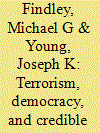

|
|
|
|
|
| Publication |
2011.
|
| Summary/Abstract |
What explains the variation in terrorism within and across political regimes? We contend that terrorism is most likely to occur in contexts in which governments cannot credibly restrain themselves from abusing their power in the future. We consider a specific institutional arrangement, whether a state has an independent judiciary, and hypothesize that independent judiciaries make government commitments more credible, thereby providing less incentive for the use of terrorism. Using a recently released database that includes transnational and domestic terrorist events from 1970 to 1997, we estimate a set of statistical analyses appropriate for the challenges of terrorism data and then examine the robustness of the results. The results provide support for the credible commitment logic and offer insights into the different ways that political institutions increase or decrease terrorism.
|
|
|
|
|
|
|
|
|
|
|
|
|
|
|
|
| 13 |
ID:
107808
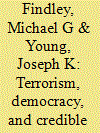

|
|
|
|
|
| Publication |
2011.
|
| Summary/Abstract |
What explains the variation in terrorism within and across political regimes? We contend that terrorism is most likely to occur in contexts in which governments cannot credibly restrain themselves from abusing their power in the future. We consider a specific institutional arrangement, whether a state has an independent judiciary, and hypothesize that independent judiciaries make government commitments more credible, thereby providing less incentive for the use of terrorism. Using a recently released database that includes transnational and domestic terrorist events from 1970 to 1997, we estimate a set of statistical analyses appropriate for the challenges of terrorism data and then examine the robustness of the results. The results provide support for the credible commitment logic and offer insights into the different ways that political institutions increase or decrease terrorism.
|
|
|
|
|
|
|
|
|
|
|
|
|
|
|
|
| 14 |
ID:
172186
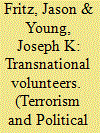

|
|
|
|
|
| Summary/Abstract |
Why do some people go abroad to engage in other people’s wars? Some studies attempt to discern why individuals choose to fight in distant lands (Malet, 2013) or seek to count how many do so (Hegghammer, 2013). The term foreign fighter has been used nearly exclusively in recent research to describe transnational fighters who join with Islamist organizations, or more generally for individuals fighting with resistance groups against a state. However, little research has been done on the many transnational fighters who travel to fight against resistance groups or against Islamist organizations. Our paper examines these transnational militants who battle against the Islamic State, focusing on Americans who engage in such activities, often referred to as volunteers. Through a review of open-source media, we created a dataset of these individuals, recording demographic data such as each individual’s military experience and stated purpose for becoming a transnational fighter. We show descriptive analyses on these data, and then compare these findings against current scholarship on Islamist transnational fighters. We argue that American volunteers and foreign terrorist fighters are phenomena with difference in degree, but not in kind.
|
|
|
|
|
|
|
|
|
|
|
|
|
|
|
|
| 15 |
ID:
134520
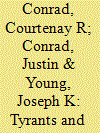

|
|
|
|
|
| Summary/Abstract |
Conventional wisdom suggests that reports of terrorism should be sparse in dictatorships, both because such violence is unlikely to result in policy change and because it is difficult to get reliable information on attacks. Yet, there is variance in the number of terrorist attacks reported in autocracies. Why? We argue that differences in the audience costs produced by dictatorships explain why some nondemocracies experience more terrorism than others. Terrorists are more likely to expect a response in dictatorships that generate high domestic audience costs. Using data from multiple terrorism databases, we find empirical evidence that dictatorships generating higher audience costs—military dictatorships, single-party dictatorships, and dynastic monarchies—experience as much terrorism as democracies, while autocracies generating lower audience costs—personalist dictatorships and non-dynastic monarchies—face fewer attacks than their democratic counterparts
|
|
|
|
|
|
|
|
|
|
|
|
|
|
|
|
| 16 |
ID:
102506
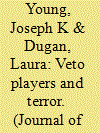

|
|
|
|
|
| Publication |
2011.
|
| Summary/Abstract |
Democratic regimes have been linked to terrorism for contending reasons, with some scholars claiming democracy increases terrorism and others claiming it decreases terror. Corroborating evidence has been used for both relationships leading to the following puzzle: why do some democratic regimes seem to foster terrorism while others do not? We offer an explanation based on Tsbelis's veto players theory. Beginning with the assumption that terror groups want to change government policy, we argue that the more veto players present in a political system, the more likely the system is to experience deadlock. Given the inability of societal actors to change policies through nonviolent and institutional participation, these systems will tend to generate more terror events. We also explore different methods for estimating terrorism models. We identify several ways to match the data with the proper statistical estimator and discuss implications for terrorism research. Finally, we use new data from the Global Terrorism Database (GTD) that was previously unavailable. These data allow us to use different operational definitions of terrorism and to identify homegrown terror events.
|
|
|
|
|
|
|
|
|
|
|
|
|
|
|
|
|
|
|
|
|